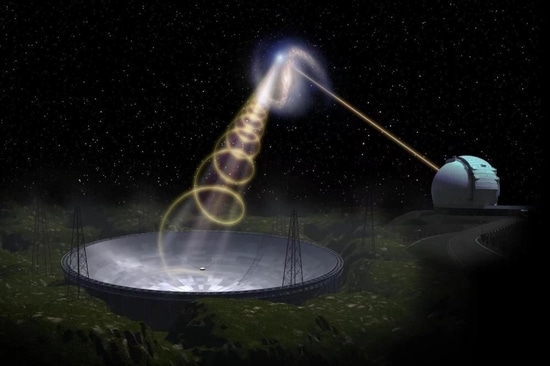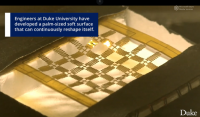The research was completed by the “China Sky Eye” FAST fast radio storm priority and major project scientific research team, and the relevant results were published in the international academic journal “Nature” on September 21.
Artistic rendering of FRBs and host galaxies. (Photo courtesy of the National Astronomical Observatory of the Chinese Academy of Sciences) Artistic image of FRBs and host galaxies. (Photo courtesy of the National Astronomical Observatory of the Chinese Academy of Sciences)
Fast radio bursts are an occasional radio burst phenomenon in the universe. The energy released in a few milliseconds is equivalent to tens of billions of times the current global electricity generation in one year. Since the existence of FRBs was first identified in 2007, it has quickly become one of the hot spots in astronomical research. Hundreds of cases have been discovered so far. However, its physical origin, surrounding environment, and central mechanism are still unclear, and there is a lack of its core. Direct observations of physical parameters in the area.
In this study, the research team conducted long-term monitoring of the fast radio burst FRB 20201124A located outside the Milky Way, and observed 1863 burst pulse signals in a total of 82 hours in 54 days. Based on this largest FRB polarization observation sample to date, the research team has made several important discoveries.
The research team discovered the strange evolution behavior of the Faraday rotation of fast radio storms for the first time. In the first 36 days, the Faraday rotation showed irregular short-time scale evolution, and it was almost unchanged in the following 18 days; the first discovery of fast radio The quenching phenomenon of the burst, that is, FRB 20201124A went from maintaining a high event rate state to abruptly extinguished within 74 hours; for the first time, a pulse of high circular polarization degree significantly different from all previous fast radio bursts was detected; for the first time, the phenomenon of frequency-dependent polarization oscillation was discovered for the first time . Through international cooperation, the team also found that the host galaxy of FRB 20201124A is a barred spiral galaxy about the size of the Milky Way and rich in metal.
“These findings show that the environment of 1 AU around FRB 20201124A is very complex and is evolving dynamically.” said Li Kejia, a researcher at Peking University/National Astronomical Observatory. The direct observational evidence of the physical process and energy mechanism of the core of the storm will reveal the physical origin of the mysterious cosmic phenomenon of fast radio bursts at an early date.




GIPHY App Key not set. Please check settings